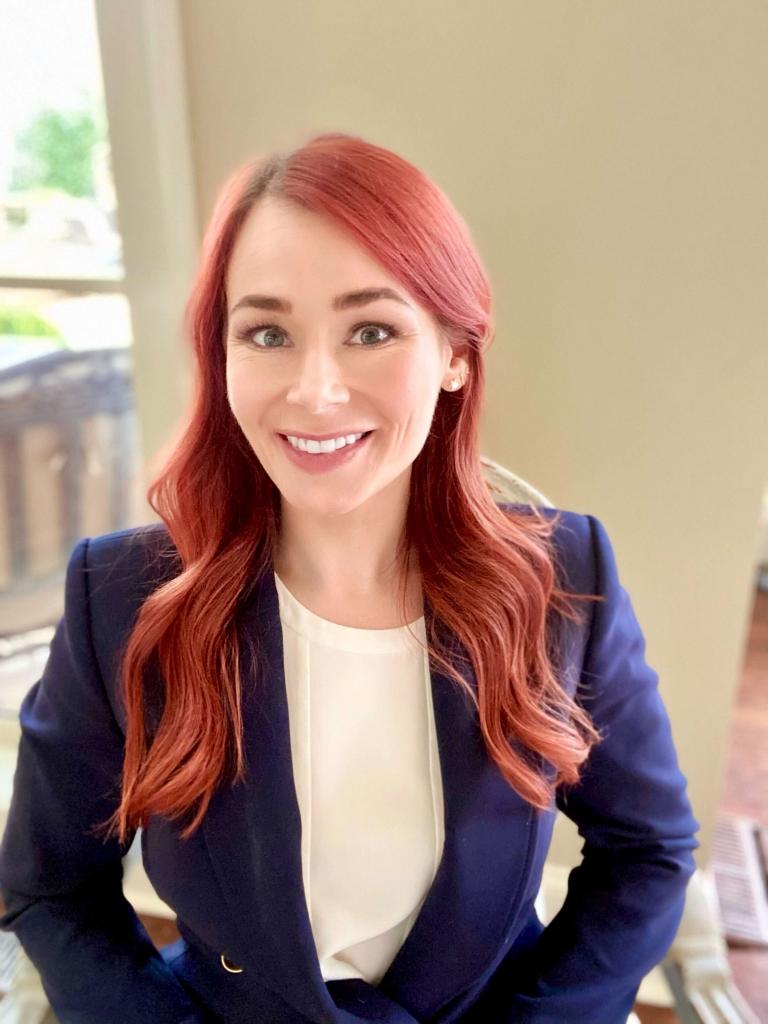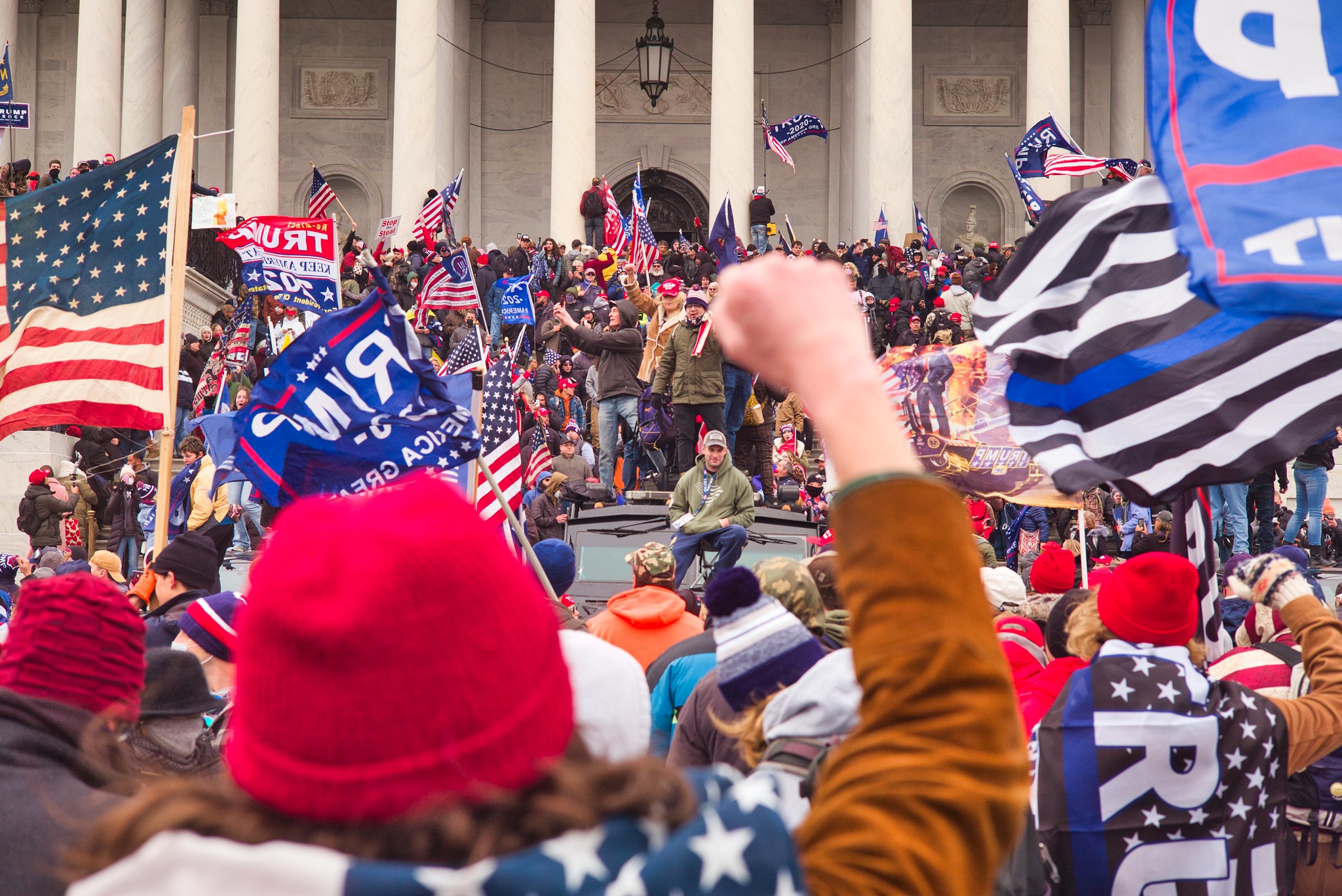Trump Faces Arraignment #3

Published by The Lawfare Institute
in Cooperation With

Outside the E. Barrett Prettyman Federal Courthouse on Thursday afternoon, where Donald J. Trump is to face arraignment in the Jan. 6 case at 4:00 p.m., the protesters show up early. Not all of their protests obviously relate to the matter at hand in court.
The most incongruous protester parades for hours by the journalists lined up outside the court, shouting, “No foreskin, No peace!” and other slogans opposing circumcision. He was here last night, too, as I waited in line alongside 60-something other journalists for a chance to get into the arraignment proceedings.
Most protesters seem at least to understand that the day’s events have something to do with Trump. I meet a guy wearing a Trump mask and an orange jumpsuit, his hands shackled by a pair of cuffs. He is there, he says, “to celebrate.” But some 20 feet away, orange jumpsuit Trump has competition. Another person, wearing a black suit and a Trump mask, holds up a sign proclaiming that Jan. 6 was not as bad as Sept. 11—which doesn’t seem much like a character reference to me. But it leads the protester to the inference that Trump is “an innocent man.”
One guy is even singing, “Hey, what’s that ‘J’ stand for, Donald J. Trump? I bet it don’t stand for JESUSSSSS.”
It actually stands for “John,” as Trump himself will inform the judge shortly.
In the years since Trump ascended to the presidency, the man has asked us to believe all manner of fantastical claims, evading complicated realities with convenient truths. It didn’t rain during his inauguration speech. (It did.) Andrew Jackson could have prevented the Civil War. (Probably not.) Drinking bleach can kill the coronavirus. (Nope.) The United States could buy Greenland. (Turns out not to be for sale.)
Trump won the 2020 election. (Uh, no.)
The odd thing is that in spinning this latter lie, Trump has created a truth that feels more improbable than any actual lie he has told: I am standing outside an American courthouse listening to a person shout about foreskins, after all, because an American president is about to be arraigned on federal criminal charges related to his alleged attempts to overthrow the results of a democratic election.
Just down the road stands the scene of the crime: The United States Capitol, where a mob of the then-president’s supporters attacked the building on Jan. 6, 2021, interrupting proceedings to certify the outcome of the election. And the courthouse where Trump will be arraigned has been the site of hundreds of trials related to the events of Jan. 6.
None of which seems to move the foreskin guy, who is now declaring, “Save the foreskin!” None of the other reporters seem fazed by this.
Inside, the courtroom is spacious, adorned with cherry wood-paneled walls and seafoam green carpet. The space is not opulent; when asked to describe the architectural style, one reporter sitting nearby describes the room as “contemporary bureaucracy.”
As the clock ticks toward the scheduled 4:00 p.m. start time, a stream of people enter the room and seat themselves in the back row of the courtroom. It is strange to see these particular people in the gallery, because they are usually seated behind the bench: It’s the chief judge of the U.S. District Court for the District of Columbia, James Boasberg, as well as Judges Amy Berman Jackson and Randolph Moss. None of their colleagues who were appointed to the bench by Trump, the defendant who is scheduled to appear moments from now, are present.
There’s also a 16-year-old kid and his mom. He wanted to witness history, apparently, and she came with him.
Special Counsel Jack Smith enters the room, flanked by Thomas Windom and Molly Gaston, two prosecutors associated with Smith’s Jan. 6 probe. As Windom and Gaston take their seats at the counsel’s table on the right side of the room, Smith finds a seat in the row of chairs just behind them, alongside assistant special counsel Raymond Hulser and several FBI agents assigned to the case.
At approximately 3:50 p.m., team Trump files into the room. First up is Evan Corcoran, a Trump lawyer who is likely to be called as a witness for the prosecution in Trump’s other federal criminal case, the one in which he is accused of illegally retaining national defense information. As he makes himself comfortable in a chair on the left side of the room, Corcoran looks over at Gaston, greeting her with a friendly wave.
The law is a fraternity above all.
Then comes the defendant, Trump, clad in the uniform he has worn to all of his court appearances thus far: navy blue suit, long red tie, crisp white shirt. He is joined by his lawyers, Todd Blanche and John Lauro, who sit on either side of him at the counsel’s table on the left side of the room.
As he awaits the judge, Trump whispers in the ear of Blanche, speaking animatedly as he occasionally gestures toward the thick stack of papers set before him on the table. Smith, as he did at the last arraignment, seems to frequently look in Trump’s direction. At one point, as the two men scan the room, they appear to make momentary eye contact.
Around 4:20 p.m.—20 minutes past the scheduled start time—Magistrate Judge Moxila Upadhyaya sweeps into court as the court officer commands, “All rise.” Trump, lingering in his chair for a moment, is the last to rise to his feet.
After asking the attorneys to introduce themselves, Upadhyaya turns to Trump. She explains that she will provide a “roadmap” for Trump regarding the charges for which he is charged, as well as his rights as a criminal defendant. Before she begins, however, she asks Trump a series of basic biographical questions. Responding to these questions, Trump says his name is “Donald J. Trump.” “John,” he clarifies.
When asked his age, Trump pipes up: “Seven-seven.”
Then Upadhyaya proceeds to move through the usual script of a federal arraignment proceeding. She advises Trump of the charges against him and his corresponding rights as a criminal defendant. He has a right to remain silent, she explains, and a right to counsel. And she announces that she will enter a “Brady” order—a court order compelling the government to produce exculpatory evidence under the Supreme Court’s decision in Brady v. Maryland.
With these advisories behind her, Upadhyaya is prepared to arraign the defendant. Trump, speaking in a subdued voice, enters his plea: “Not guilty.”
Then Upadhyaya turns to the release conditions, which she says the government and Trump’s team have agreed to in advance of the hearing. She announces the conditions for the record: First, Trump cannot commit any new state, federal, or local criminal offenses and, second, Trump must appear in court as may be required at future hearing dates. Additionally, as with his conditions in the Mar-a-Lago documents case, Trump must not communicate about the case with potential witnesses except through counsel. Violating these conditions, the magistrate warns, could result in Trump being held in custody pending trial or a longer sentence.
“Do you understand?” Upadhyaya asks.
“Yes,” Trump almost whispers, his voice barely audible.
Having arraigned Trump, the magistrate judge turns to the final issue of the day: scheduling a date for the next hearing. To that end, Upadhyaya announces that she’s consulted with the judge assigned to preside over the case, district court Judge Tanya Chutkan, who provided three dates for the next hearing: Aug. 21, Aug. 22, and Aug. 28.
Turning to the special counsel’s office, she asks which date the prosecution would prefer. “Your honor, the government is available on all three dates,” Windom replies without hesitation.
Trump’s team, naturally, would prefer the latest possible date: “Your honor, we would request Aug. 28,” Lauro says.
Granting Lauro’s request, Upadhyaya sets the first hearing for Aug. 28, while specifying that Trump can waive his appearance should he choose to do so.
Then she orders the first briefing in the case. Explaining that Chutkan intends to set an initial trial date at the Aug. 28 hearing, Upadhyaya orders the government to file a brief for a tentative trial date within seven days. In turn, she continues, the defense must file a response within seven days after that.
At this, Lauro jumps to his feet to be heard. Your honor, he says, in a case of this magnitude there might be massive discovery to look through, and defense counsel must have time to do so in order to make a determination about when it could go to trial. At the very least, he would ask that prosecutors indicate the volume of discovery they expect to produce in the case, within “two or three days.”
Windom, in response, stresses that prosecutors intend to produce “a substantial amount of discovery” as soon as a protective order can be issued to regulate the sharing of evidence in the case. Like any other case, Windom continues, this case “will benefit from normal order, including a speedy trial.”
Upadhyaya chooses to maintain her earlier order: Both parties will be required to file proposals for tentative trial dates by Aug. 17. Trump, she says, will get a “fair trial” in the District of Columbia, but Chutkan intends to set a trial date at the Aug. 28 hearing.
Lauro, testing his luck once more, again rises to his feet. He complains that the defense does not yet know the scope of the evidence and that he would like to get some sense of the “magnitude” of the case before proposing a trial date. Moreover, he continues, it is “absurd” to think that this case could be tried within the 70-day period set out in the Speedy Trial Act. The government, he says wrongly, has had “three and a half years” to investigate the case. He declares that he intends to make a request to toll the speedy trial clock “until the next hearing and beyond.”
Upadhyaya, however, isn’t having it. She says she will note that Lauro made an oral motion to toll the speedy trial clock and that she ordered the government to respond within five days.
And with that, we’re done. Trump exits the courtroom, while Smith chats jovially with an FBI agent.
Outside the courthouse, the pro-foreskin protester is still at it. The former president may be facing trial for trying to subvert the constitutional order, but the protester has his eye on the real threat to our society.





